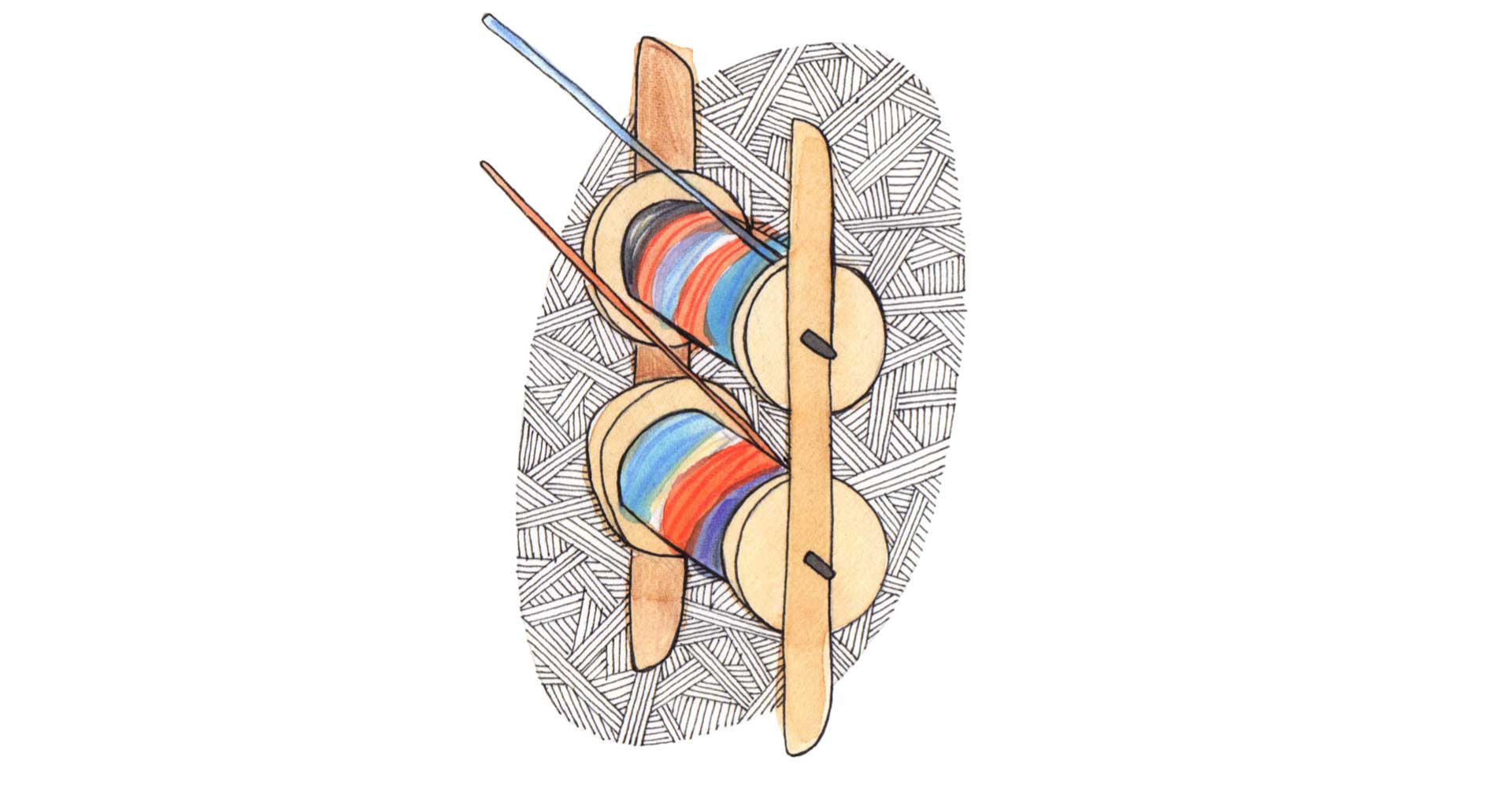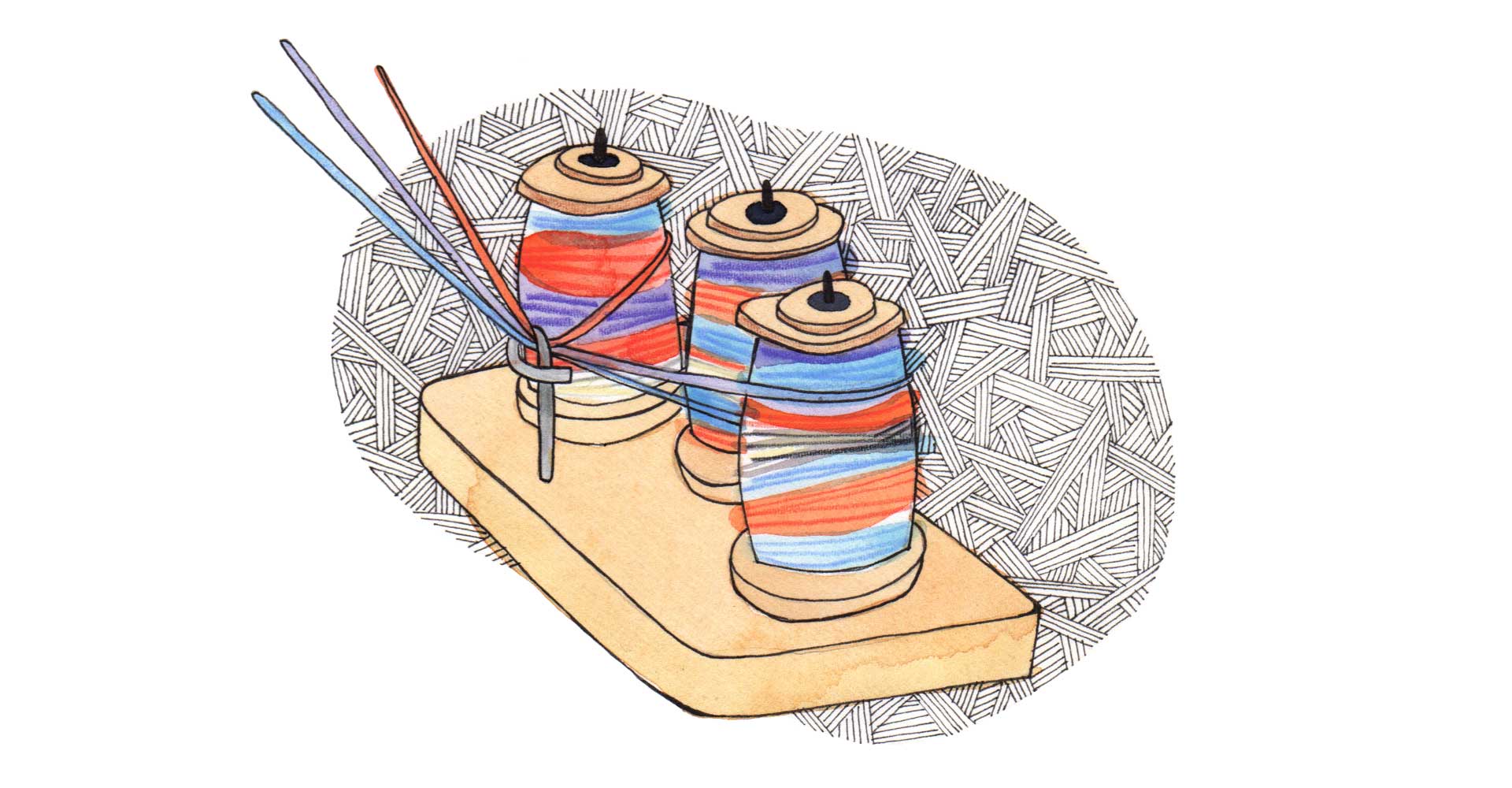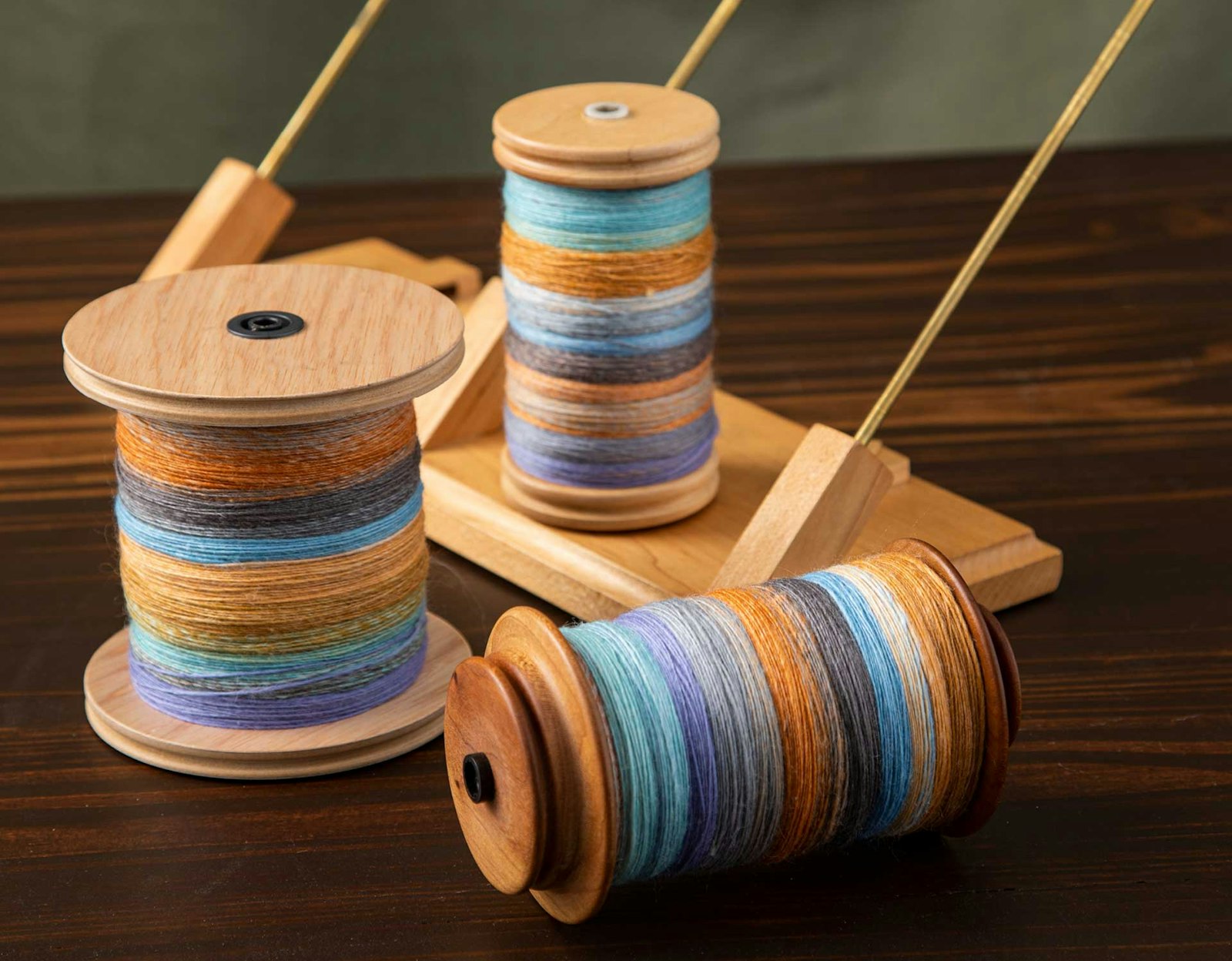A lazy kate is a device that spinners use for the process of plying. These clever tools have shafts that are similar in diameter to a shaft on a spinning wheel flyer and hold bobbins loaded with fibers ready for plying, usually handspun singles. The bobbins held by the lazy kate are unloaded as the newly plied yarn is spun onto an empty bobbin on the wheel. This is a simple idea, but there are several types of lazy kates—also sometimes called spool knaves or bobbin caddies—and choosing the right one can greatly improve your plying experience.
Most lazy kates will hold two to four bobbins at a time, allowing you to make two-ply, three-ply, and four-ply yarns. If you want to make yarns with more than four plies, you can use more than one lazy kate.
Some spinning wheels come with a built-in lazy kate that can be used for plying or simply for bobbin storage. There are also many styles of lazy kates that are not attached to the wheel. Some of those unattached lazy kates are quite large and bulky; others fold up neatly and are terrific for travel. My personal preference is to use an unattached lazy kate; it allows me to do specialty plying more easily, such as creating snarl yarns or knot yarns. Another advantage of an unattached lazy kate is that you can put it in a variety of locations: on the floor, on a table, or across the room.
Bobbin Orientation
Lazy kates usually have bobbin shafts positioned in one of three ways: horizontally, vertically, or at an angle. The orientation of the shafts, and therefore of the bobbins, influences plying in two important ways. First, with horizontal and angled orientations, the weight of the bobbin itself will provide some friction against the shaft. This helps to slow the bobbin’s rotation, giving the spinner more control.

Lazy kate holding bobbins in a horizontal orientation. Illustration by Katie Eberts
Second, during the plying process, the spun fiber needs to flow off the bobbin perpendicular to the length of the bobbin and the shaft of the lazy kate. Otherwise, you may be adding or subtracting twist in the singles that are coming off the bobbin. I have found this to be more of a challenge with vertical bobbin orientations. For example, if a vertically oriented lazy kate is on the floor, the singles tend to come off the bobbin in the direction of the shaft of the lazy kate. If that happens, you may not only be adding or subtracting twist but you can also find that your fiber tangles around the shaft of the lazy kate.

Lazy kate holding bobbins in a vertical orientation with singles passing through a pigtail guide. Illustration by Katie Eberts
There are a couple of strategies to avoid these problems. Many vertical lazy kates come with an eyelet so that when the singles yarn on the bobbin goes through the eyelet, it will automatically be coming off the bobbin perpendicular to the shaft. I’ve seen two types of eyelets: either a closed loop or a “pigtail” eyelet. Unlike the closed loop, the pigtail eyelet allows you to remove singles coming off the bobbin in the middle of plying without having to cut or break them. If your lazy kate does not have such an eyelet, place the lazy kate on a table, or at least higher up than floor level, so that the singles yarn on the bobbin is more likely to come off the bobbin perpendicular to the shaft.

Lazy kate holding bobbins at an angle. Illustration by Katie Eberts
Tensioned Lazy Kates
A “tensioned” lazy kate, also referred to as an “industrious” kate, is one that uses a tensioning band to control the rotation of the bobbins on the lazy kate. This band acts much like the brake band used in the scotch-tension mechanism on a spinning wheel that controls take-up during spinning (see “Developing Your Skills: Scotch Tension,” Spin Off, Fall 2011).
There is typically a knob on the kate to tighten or loosen the band. The band goes from the knob around the grooved base of each bobbin on the kate and is then rigidly attached to another part of the kate. By tightening the band, you increase friction on the bobbins, requiring more force to pull the singles off the bobbins.
To easily get exactly the amount of tension that you want, it is important that the tensioning band have some elasticity. Either the band itself is made from something reasonably stretchy, or if the band is more rigid (cotton or linen), then it usually has some sort of elastic element, such as a gentle spring or a rubber band, in series with the band.

Tension bands can be found on many types of lazy kates. Typically, for a cotton or linen band that fits in each bobbin groove, at one end of the band is a gentle spring or rubber band, and the other end attaches to a tension knob. Illustration by Katie Eberts
When to Use Which Kate
In most cases, if you want to make a two-ply yarn, you will need a lazy kate that has at least two shafts. Likewise, you will need three shafts for a three-ply yarn and four shafts for a four-ply yarn.
Of course, there are other plying strategies. If, for example, you want to make a chain-plied three-ply yarn, you will only have one bobbin on the lazy kate. If you want to make cabled or crêpe yarns, you will need fewer shafts on the lazy kate than for standard three- or four-ply yarns. If you are fond of making textured, designer, or art yarns, you may find it useful to have more than one lazy kate; sometimes, it is helpful to have the singles flow from different locations so that you can control them separately with left and right hands.
Whether you want to use a tensioned lazy kate may in part depend on your spinning personality. I do especially love my tensioned lazy kates. I think that’s because I am an impatient plyer. As soon as my bobbins of singles are full, I want to ply. Immediately. Many accomplished spinners suggest allowing the singles to rest on the bobbins for a day or longer so that they will be more manageable in the plying process. I simply can’t wait that long, and I have found that a tensioning band on a lazy kate allows me to ply even the most willful of singles.
For a wheel spinner who makes plied yarns of all kinds, lazy kates are essential tools. They have given me the freedom to play with plying.
Amy Tyler spins and plies—and writes about such things—in northwest lower Michigan. She also travels to teach spinning. Amy values all her spinning wheels and spindles, and she is charmed by all the accessory tools that are used to make yarn. You can find out more about her on her website, stonesockfibers.com.
This article first appeared in Spin Off Fall 2021.

